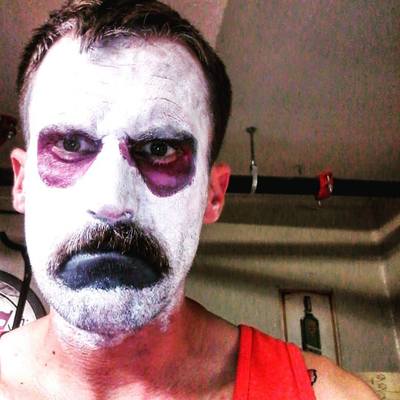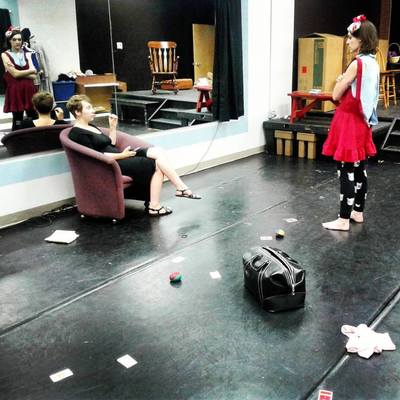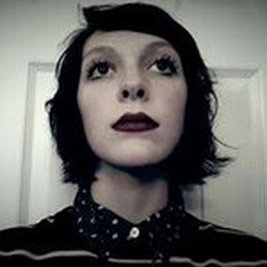|
|
Slouch and Grouch: Das Kapital, July 2018. Fort Collins Fringe Festival 2nd place winners of Audience Choice Award
Slouch and Grouch are a comic duo that split from a single clown cell and are on a hilarious quest to discover what it means to be human. Think Laurel and Hardy or Ren and Stimpy power and creative dynamic. Between murder clowns and kids birthday clowns they exist on the spectrum. However, Slouch and Grouch is for people of all ages. They are new to the world and their innocence as they navigate life on earth is funny and moving. Slouch and Grouch subvert gender norms, comment on social conventions, and shake up the notions we've taken for granted. Most importantly, they are a slice of distilled humanity with all its flaws, desires, and pettiness but with all its grace and beauty as well. They have their own language. They approach everything with wonder and, hopefully, make the audience see things from an different perspective. While this all sounds really cheesy, they also are violent, scary, and cruel at times, like real people! With a DIY seat of the pants and skin of the teeth energy, the creatores of Slouch and Grouch love to collaborate with makers of all kinds to create devised, original multimedia performances. Slouch and Grouch is the original creation of Natalie Scarlett, Nick Holland, and Frances Lister and produced by Cipher Creative Productions. See more on creators below. |
Nick HollandNick (Grouch) is an actor, writer, artist, filmmaker and co-creator of Slouch and Grouch in Fort Collins. He runs a script incubator called "The Fort Collins Yacht Club" and has appeared in several plays, short films, and comedic performances.
|
Frances ListerFrances (Slouch) is a dancer, actor, choreographer, and co-creator of Slouch and Grouch in Fort Collins. Most recently she performs and choreographs for Bas Bleu theatre.
|
Natalie ScarlettNatalie is a director, writer, teacher, and actor in Fort Collins. She is the director and co-creator of Slouch and Grouch. She wrote and directed "The Eggplant, and Other Domestic Incidents" and is actively involved in the Fort Collins Fringe Festival.
|
Essay by Natalie Scarlett
These clowns are my religion.
Fooling around, a clown is really performing a spiritual ceremony. --John (Fire) Lame Deer, Lakota Medicine Man
In First Nation or Native American society, the clown has a sacred task on par with the role of the medicine man or shaman. Their purpose is to maintain order, order through disorder. The theory is that if something is wise or true enough to withstand the profanity of the clown’s ridicule then it is worthy of its place in society, be that a person, system, law, or sacred rite. They keep society safe by being unafraid to speak forbidden words, face difficult issues, and initiate action on behalf of all. They challenge authority and have a sacred mandate to question, tease, and satirize. The Lakota heyoka or clown is human, hyper-human, and they experience fear as we do but also know that their responsibility as a release valve in society is greater that their human limitations. Their imperative, to keep everything in check through their humor, requires absolute freedom of expression. Nobody is too important to be immune from their commentary and so their art is inherently egalitarian. The clown fulfils his or her sacred duty keeping all, the individual, the collective, and the divine in check and ensures the survival of what the collective holds holy or tempers what is commonly accepted. By participating in sacred rites, the clown is the voice of the Everyman doing and saying all the blasphemous and profane things we want to say and thereby usurping the power of irreverence and upholding the sanctity of the ceremony. The clown in the conduit through which mortals can experience the divine because their heads are in the heavens while their feet are firmly on the earth. While there is no universal Native belief system or deity, there is one common thread in most Native philosophies: “All the Indian religions are somehow a part of the same belief, the same mystery. Our unity, it’s in there. (Lame Deer, 2009). Wholeness is the most important concept: nature, animals, plants, humanity, day, night, good, evil, man, woman. Wholeness is simple. It is inclusive and non-judgmental. It’s accepts all that we are and all that there is. The Native clown ensures survival by making us laugh, by celebrating the wholeness and restoring balance by acknowledging evil, shame, and weakness. Most belief systems, particular the Abrahamic religions, deny our dark and sinful nature as “from the devil” and secret away our sins to bolster righteous egos, but the indigenous concept of wholeness acknowledges that shame and flaws, as illustrated by the clown, are truly human. Slouch and Grouch derive their names from this very idea, choosing to highlight flaws within themselves in their mannerisms, characters, and even posture. The actions of the clown embody our vulnerability, shame, and fear and in doing so the collective fear is released through laughter at them, seemingly, but really at ourselves. The heyoka honestly elicits our laughter and understanding when they lay themselves bare by re-enacting their stupid, shameful, ridiculous secrets for the common good. They restore balance and harmony. But, in the words of Sue Morrison, “Laughter and tears live in the same place in people and when they are so close how can you say that clown is only laughter? Clown is a much more profound thing than just making us laugh. If a clown just makes us laugh you lose the purpose, the divine purpose perhaps, of their function.” The clown’s function, to ensure our survival, is most serious. The concept of Native wholeness would have us believe that laughter is the natural companion of seriousness. Therefore, the clown, in executing a most serious task does so to most complete effect when utilizing its opposite, laughter. We contend that the theatre is a secular place of worship and that a dance between the sacred and the profane is our way of exploring the divine within. The clown is our guide whose sole purpose is to provide the audience with access to a sacred space where truth and imagination collide. Their beautiful truth, our awful truth, in a delightful, shared fiction. And when such change occurs, when transformation in the form of understanding—intellectual, emotional or spiritual is achieved, we access the divine within.
(The primary source in writing this and developing Slouch and Grouch: Universal Remote was “Clown Through Mask” by Veronica Coburn and Sue Morrison. Talk to Natalie Scarlett if you have more questions about the process. )
These clowns are my religion.
Fooling around, a clown is really performing a spiritual ceremony. --John (Fire) Lame Deer, Lakota Medicine Man
In First Nation or Native American society, the clown has a sacred task on par with the role of the medicine man or shaman. Their purpose is to maintain order, order through disorder. The theory is that if something is wise or true enough to withstand the profanity of the clown’s ridicule then it is worthy of its place in society, be that a person, system, law, or sacred rite. They keep society safe by being unafraid to speak forbidden words, face difficult issues, and initiate action on behalf of all. They challenge authority and have a sacred mandate to question, tease, and satirize. The Lakota heyoka or clown is human, hyper-human, and they experience fear as we do but also know that their responsibility as a release valve in society is greater that their human limitations. Their imperative, to keep everything in check through their humor, requires absolute freedom of expression. Nobody is too important to be immune from their commentary and so their art is inherently egalitarian. The clown fulfils his or her sacred duty keeping all, the individual, the collective, and the divine in check and ensures the survival of what the collective holds holy or tempers what is commonly accepted. By participating in sacred rites, the clown is the voice of the Everyman doing and saying all the blasphemous and profane things we want to say and thereby usurping the power of irreverence and upholding the sanctity of the ceremony. The clown in the conduit through which mortals can experience the divine because their heads are in the heavens while their feet are firmly on the earth. While there is no universal Native belief system or deity, there is one common thread in most Native philosophies: “All the Indian religions are somehow a part of the same belief, the same mystery. Our unity, it’s in there. (Lame Deer, 2009). Wholeness is the most important concept: nature, animals, plants, humanity, day, night, good, evil, man, woman. Wholeness is simple. It is inclusive and non-judgmental. It’s accepts all that we are and all that there is. The Native clown ensures survival by making us laugh, by celebrating the wholeness and restoring balance by acknowledging evil, shame, and weakness. Most belief systems, particular the Abrahamic religions, deny our dark and sinful nature as “from the devil” and secret away our sins to bolster righteous egos, but the indigenous concept of wholeness acknowledges that shame and flaws, as illustrated by the clown, are truly human. Slouch and Grouch derive their names from this very idea, choosing to highlight flaws within themselves in their mannerisms, characters, and even posture. The actions of the clown embody our vulnerability, shame, and fear and in doing so the collective fear is released through laughter at them, seemingly, but really at ourselves. The heyoka honestly elicits our laughter and understanding when they lay themselves bare by re-enacting their stupid, shameful, ridiculous secrets for the common good. They restore balance and harmony. But, in the words of Sue Morrison, “Laughter and tears live in the same place in people and when they are so close how can you say that clown is only laughter? Clown is a much more profound thing than just making us laugh. If a clown just makes us laugh you lose the purpose, the divine purpose perhaps, of their function.” The clown’s function, to ensure our survival, is most serious. The concept of Native wholeness would have us believe that laughter is the natural companion of seriousness. Therefore, the clown, in executing a most serious task does so to most complete effect when utilizing its opposite, laughter. We contend that the theatre is a secular place of worship and that a dance between the sacred and the profane is our way of exploring the divine within. The clown is our guide whose sole purpose is to provide the audience with access to a sacred space where truth and imagination collide. Their beautiful truth, our awful truth, in a delightful, shared fiction. And when such change occurs, when transformation in the form of understanding—intellectual, emotional or spiritual is achieved, we access the divine within.
(The primary source in writing this and developing Slouch and Grouch: Universal Remote was “Clown Through Mask” by Veronica Coburn and Sue Morrison. Talk to Natalie Scarlett if you have more questions about the process. )
















